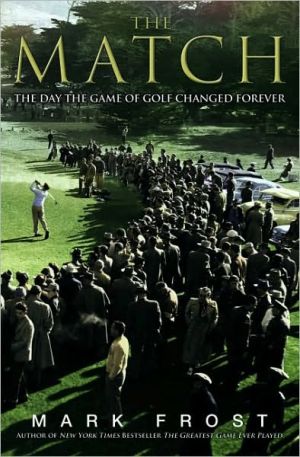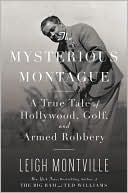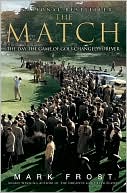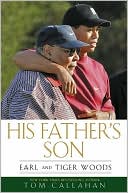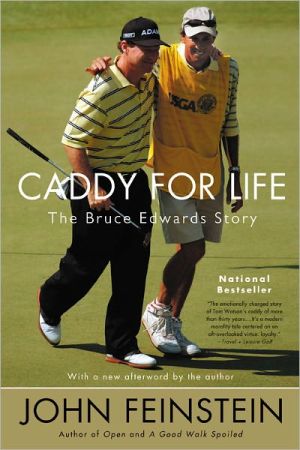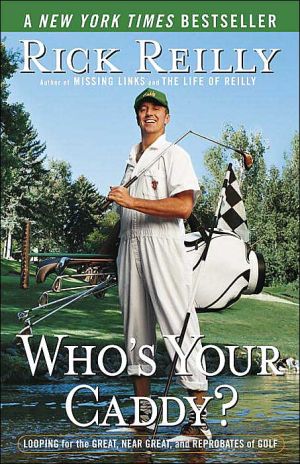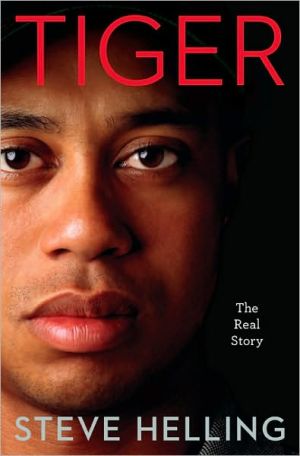How I Play Golf
There is simply no athlete quite like Tiger Woods. His domination of golf is unparalleled. His achievements at the beginning of his career are extraordinary. And his approach to the game, from the power of his drives to the discipline of his mind, stands a cut above that of his competitors.\ Now Tiger Woods has written his book about how he plays golf, offering us an intimate view of both his game---mental arid physical-and his unique personality on and off the course.\ Golf fans everywhere...
Search in google:
There's no denying that Tiger Woods has taken golf by storm. It seems like every time this 25-year-old swings a club, another PGA record is shattered. While his explosive drives, accurate approach shots, and steady putter certainly contribute to this success, both fans and critics agree that it's Tiger's devastating mental game that has propelled him to become the premier golfer of our time. Now Tiger shares his thoughts on what he calls the game of a lifetime. He reveals the five secrets he believes are responsible for his success-a combination of physical, metaphysical, and psychological practices he uses daily to keep his game in top shape and help him to transcend all the ups and downs of golf. Best of all, Tiger reveals his unique approach to the game for the first time ever in this one singular volume. Publishers Weekly Very few sports figures have accomplished as much as Woods has already achieved at age 25. He has been named "Sportsman of the Year" by Sports Illustrated twice; he has won more than 30 professional tournaments and he's the youngest player to win the Grand Slam four of the major pro championships. Despite his many commercials and product endorsements, Woods is one of the rare athletes who isn't overplayed in the media. Unlike many other sports stars, Woods plays and wins quietly. That may explain why this instructional book will reach far beyond the links. Woods talks about his experiences and his attitudes toward golf and life. The conversational tone is quite engaging: "The difference between golf and most other sports is that anyone of average intelligence and coordination can learn to play it well. It requires a commitment to being the best that you can be. That has always been my approach to the game.... Pop gave me many great lessons, not only about golf, but also about life. His greatest advice to me was always be myself." On watching the ball, Woods says, "If you're like me, you can't wait to see if the ball is tracking toward the hole right after the golf ball leaves the putterface.... The tendency to peek too soon causes your head to move and leads to off-sloppy contact.... I found an effective way to fight the problem: I practice putting with my left eye closed, so I can't see the target line at all with my peripheral vision. That makes it easier to keep my eyes looking straight down." Accompanied by wonderful photos, the book reads as if Woods is right there with the golfer, providing instructions. (Oct.) Forecast: With scheduled appearances on Oprah and Dateline along withextensive print and television advertising, this book will immediately shoot out of the bookstores. Strong sales should continue for a long time. Copyright 2001 Cahners Business Information.
Excerpt from\ How I Play Golf\ Yearning to Learn\ I love golf as much for its frankness as for those rare occasions when it rewards a wink with a smile. It is pure, honest and immune to sweet talk. Neither can it be bum-rushed. You must court it slowly and patiently. Any other strategy will ~ be met with a rebuff that for centuries has made grown men and women cry.\ Golf does, however, show you moments of vulnerability. They are the reason we relish the courtship and the basis for our hope. It is that flicker of anticipation that draws us from the comfort of ambivalence to the certainty of rejection. Golf does not play favorites. Still we try.\ I have been infatuated with the game since my pop first put a club in my hands when I was a toddler. I was an only child, and the club and ball became my playmates. That feeling of solitude and self-reliance enhanced the game's attraction for me and endures today. I suspect that is true of most people who have succumbed to the lure of the game. I recall from conversations with two of the greatest golfers of our time—Arnold Palmer and Jack Nicklaus—that the game had a similar appeal for them. Golf affords you supreme independence. The clich? about the game being you against the golf course is only partly true. Ultimately, it is you against yourself. It always comes down to how well you know yourself, your ability, your limitations and the confidence you have in your ability to execute under pressure that is mostly self-created. Ultimately, you must have the heart and head to play a shot and the courage to accept the consequences.\ Golf is a great mirror, often revealing things about you that even you didn't know. It cannot be misled. Still we try.\ Sometimes the game comes so easily you can hardly believe it. Every swing seems natural and unforced. Every shot comes off exactly as you envisioned it. That false sense of security is part of the seduction. Every golfer has experienced it. If we are honest with ourselves, we'll admit never quite reaching nirvana—that feeling of invincibility. We are constantly on edge. There is no comfort zone in golf. Nor is it a game of perfection. If it were, we'd all shoot 18 and look for a more challenging sport. I shot a 61—my lowest competitive round—in the third round of the Pac-10 Championships during my sophomore year at Stanford and bogeyed the par-4 14th hole. I actually hit the ball better during the afternoon round and shot four strokes worse, including a bogey at 15. Only once do I recall feeling nearly in control of my game and that was when I shot a 13-under-par 59 at my home course in Orlando. Even then I parred both par 5s on the back nine with irons into the greens. The most we can ask of ourselves is to give it our best shot, knowing that sometimes we will fail. We are often defined by how we handle that failure.\ The great Ben Hogan, a man not prone to exaggeration, claimed that in his best week of golf he only had four perfect shots. I have yet to get to that higher plane. I won 12 times around the world in 2000, including three majors, and I only remember hitting one shot I would call perfect—a 3-wood on No. 14 on the Old Course at St. Andrews in the third round of the British Open. From a tight lie I had to hit a little draw into a left-to-right wind and carry the ball about 260 yards to a green guarded by a couple of nasty pot bunkers. As with every shot I attempt, I visualized the ball's flight and how it should respond upon landing. Because it was a blind shot, I picked out a crane in the distance as my target. The ball never left that line and the shot turned out exactly as I had planned. Moments like that stay fresh in my mind, providing a positive image for future reference. Those images are critical when the game is on. They may even be the difference between success and failure.\ Sometimes the game seems so difficult you wonder whether the effort is worth it. It took me a while to understand why some days you have it and others you don't. Fact is, every day your body feels a little different and golf is such a finite game that a little off can translate into a lot. One or two degrees here and there can mean from four to seven yards. That's not a whole lot but it's magnified due to the precision the game demands. We've all had one of those frustrating days. The final round of the 1996 NCAAs at The Honors Course in Ooltewah, Tenn., was one I'll never forget. I struggled all week, even though I shot some great numbers. I just didn't feel comfortable with my swing. I didn't have the club in the right position, but I was getting away with it because my chipping was great and I made every putt I looked at. I was somehow able to keep the ball in play for most of the holes and let my putter do the rest. In the final round I lost it altogether. I went to the range that morning and never hit a shot. It just wasn't there. Sometimes when that happens you can actually lower your expectations, go out and shoot a great round. Not this time. I played the first three rounds with smoke and mirrors and it finally caught up with me. Fortunately, I had a nine-shot lead and the 80 didn't cost me an individual championship. I felt extremely fortunate, more like a survivor than a champion.\ Success in golf is finding equilibrium, accepting the fact that it is a game of ups and downs and learning something every time you tee it up. Finding that balance is a matter of trial and error. You must discover what works best for you and work diligently to maximize your potential. The difference between golf and most other sports is that anyone of average intelligence and coordination can learn to play it well. It requires a commitment to being the best that you can be. That has always been my approach to the game, for I, too, started as a blank page. Through my first teacher, my dad, the page began to fill. I absorbed as much information about the game as I possibly could. Through experimentation I started weeding out what could and could not hurt me. More important, I began to understand what worked best for me. Pop gave me many great lessons, not only about golf but also about life. His greatest advice to me was to always be myself. I pass that along to you as the first lesson in this book, which I wrote not as a panacea but as the ultimate tribute to Mom and Pop's ideal of caring and sharing. In essence, if you care for someone you'll share with them your most treasured possessions.\ In this book I will share with you a lifetime, albeit a relatively short one, of knowledge about the greatest game in the world. I believe this book will assist you in attaining the deep joy and satisfaction that comes from playing the game well. I am convinced there is no game like it. In many ways it is a microcosm of life, teaching us both the depths and heights of character. It demands integrity, promotes camaraderie, encourages good health and builds appreciation for the aesthetics. It is more than a well-struck iron or a holed putt. No, golf is not a game of perfection; it is one of reality. And keeping it real is more than a worthy goal in any endeavor.\ Golf requires patience and perseverance. There are no shortcuts. Pop used to say you get out of it what you put into it. When my teacher, Butch Harmon, and I overhauled my swing during the 1998 season, Butch would sometimes have me repeat one movement for 30 minutes. I would get so tired it felt like my arms were going to fall off. But I kept at it until the move became ingrained in my muscle memory. Patience and practice pay off. So will careful attention to the techniques explained within the pages of this book—techniques I believe will work for everyone seeking to get the best out of their games. It is structured differently from other books, beginning with the green and progressing to the tee. That's how my dad taught me, from the smallest swing to the biggest. The instruction combines visual, kinesthetic, cognitive and performance ideals for practical application by players of all ages and abilities. Interspersed throughout the text are seven secrets I have used to elevate my game, from becoming physically stronger to mentally tougher. I believe they will work for you, too.\ Ultimately, golf is a journey full of learning and discovering. I hope, through this book, you'll discover your game—one that is powerful yet precise, consistent yet exciting, impervious to pressure yet yielding large doses of fun. After all, that's the real reason we play the game. Sometime we forget that. I did once. I was a junior golfer playing in the Orange Bowl junior tournament in Miami. I had the lead going into the final round and made a double on the front nine. I still had the lead, but for some reason I lost all joy and flat-out quit. I took my second-place trophy and pouted. Pop sternly reprimanded me. That's the only time I ever quit on golf in my life. From that time on I realized what a privilege it is to play. And I never again lost sight of why I fell for the game in the first place.\ We still try because we must...
Preface ..... viii Foreword ..... x Acknowledgments ..... xiii How to Start Yearning to Learn ..... 3 Chapter 1: How to Putt Rolling the Rock ..... 21 Chapter 2: How to Get It Down Turning Three into Two ..... 45 Chapter 3: How to Escape from Sand Making the Hard Easy ..... 65 Chapter 4: How to Swing Building an Action to Last ..... 85 Chapter 5: How to Flag Your Irons Knocking Down the Pin ..... 115 Chapter 6: How to Nail Fairway Woods Playing the Versatile Clubs ..... 143 Chapter 7: How to Smoke the Driver Going With All You've Got ...... 159 Chapter 8: How to Handle Problems When it Starts Getting Ugly ..... 207 Chapter 9: How to Stay In Control Managing Your Game ..... 237 Chapter 10: How to Master the Mind Winning Psychology ..... 255 Chapter 11: How to Get Strong Surviving as the Fittest ..... 275 Chapter 12: How to Play Enjoying the Journey ..... 295 Afterword ..... 306
\ From Barnes & NobleThe Barnes & Noble Review\ At the age of 25, Tiger Woods already ranked as one of the greatest golfers of all time. How I Play Golf is Tiger's debut instructional guide on the mental, physical, and emotional approach to the sport he has mastered. Rather than telling readers how to golf, Woods tells readers how he golfs. It is a brilliant touch -- who better to emulate? \ Tiger first illustrates his putting technique, then describes how he pitches, punches, chips, and blasts irons and woods from the tee and the fairway. A few things that have helped his game: a consistent preshot routine and lightening up on the grip (especially when putting). Betraying his expertise, Tiger harps on some aspects of golf many of us have never considered: for example, what is the proper approach to a ball resting in an incidental sand divot in the middle of the fairway? How should one grip a three-wood for a short chip to the green, hit a mud-splotched ball, or a ball partially submerged in water?\ In addition to mechanical instruction, Tiger describes the physical preparation and mental approach that have enabled him to play this bedeviling sport for fun and profit. Though Tiger's been golfing since his days in the crib, he hasn't always had the habits of a champion. There isn't a harder worker on the tour; indeed, there isn't anybody who so personifies golf as does Tiger Woods. Understanding how he plays and approaches the sport will help readers reduce their handicap significantly. Just as Tiger copied Jack Nicklaus's interlocking grip, readers may adopt Tiger's techniques. Upon finishing the book, one could proudly claim (in the spirit of the Nike commercials), "I am Tiger Woods!" (Brenn Jones)\ \ \ \ \ \ Publishers WeeklyVery few sports figures have accomplished as much as Woods has already achieved at age 25. He has been named "Sportsman of the Year" by Sports Illustrated twice; he has won more than 30 professional tournaments and he's the youngest player to win the Grand Slam four of the major pro championships. Despite his many commercials and product endorsements, Woods is one of the rare athletes who isn't overplayed in the media. Unlike many other sports stars, Woods plays and wins quietly. That may explain why this instructional book will reach far beyond the links. Woods talks about his experiences and his attitudes toward golf and life. The conversational tone is quite engaging: "The difference between golf and most other sports is that anyone of average intelligence and coordination can learn to play it well. It requires a commitment to being the best that you can be. That has always been my approach to the game.... Pop gave me many great lessons, not only about golf, but also about life. His greatest advice to me was always be myself." On watching the ball, Woods says, "If you're like me, you can't wait to see if the ball is tracking toward the hole right after the golf ball leaves the putterface.... The tendency to peek too soon causes your head to move and leads to off-sloppy contact.... I found an effective way to fight the problem: I practice putting with my left eye closed, so I can't see the target line at all with my peripheral vision. That makes it easier to keep my eyes looking straight down." Accompanied by wonderful photos, the book reads as if Woods is right there with the golfer, providing instructions. (Oct.) Forecast: With scheduled appearances on Oprah and Dateline along withextensive print and television advertising, this book will immediately shoot out of the bookstores. Strong sales should continue for a long time. Copyright 2001 Cahners Business Information.\ \ \ Library JournalWoods's very popular book of personal golf techniques has been transformed into a gem of an instructional audiotape. He teaches the listener the essential physical and psychological aspects of golf, from putting and the short game to the tee shot and the mechanics of one magnificent drive. There is a photo booklet that shows proper positioning of the body, hands, and club for each aspect of Woods's game, which is essential to understanding his methods; keeping track of that booklet in circulation is a potential problem. Listeners are encouraged to stop the tape, examine the booklet, and practice the techniques throughout. There are enough illustrations from Woods's golf exploits to keep the program interesting and to motivate the listener to pick up a club and give it a try. The author explains golf down to the lifestyle: technique, continuous practice, exercise, diet, attitude, and love for the game. Excellently read by Walter Franks, this is very highly recommended. Cliff Glaviano, Bowling Green State Univ. Libs., OH Copyright 2002 Cahners Business Information.\ \

